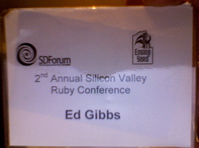
Two days at the San Jose Tech Museum hearing about Ruby rejuvenated the old cranium. Just in time since I had spent the previous day doing about 14 hours of troubleshooting on some Enterprise software.
The conference had somewhere above 100 attendees (I didn’t count). It was all in one big hall on the first floor of the Tech. The chairs, well they were bad and know tables to drop a laptop. Still for about $250 for two days I can’t complain too much about the chairs.
The talks ranged from Ruby testing techniques and libraries to IDEs and even into a good bit of depth on VMs and compilers since there were talks on Rubinius and JRuby. At least 10 people in the room had open positions and if you’re a Ruby developer now there’s little chance you can’t find lots of work in Silicon Valley. A decent portion of the audience even had at least one patent.
As a manager dealing day to day with the Java world I felt in over my head as far as Ruby expertise, and it was great. When I go to more general software conferences or Java talks I often get less out of them because I have a lot of experience. Here I was in the bottom third of the class and it was nice. Everything is still shiny and new.
Since there was only one track you didn’t have to do any deciding and walk out of a session feeling like you made a mistake. Another nice part was most of the presenters were very focused and often finished ahead of there hour or so. Instead of sort of filling the time up they generally gave up the floor for lightning talks or answered questions. The self-organization was evident.
Coming down from Sacramento the drive was reasonable, and I just crashed at a $80 hotel room Saturday and headed home Sunday afternoon. Given a really long week at work I didn’t have as much energy as I usually do for socializing, but I did manage to spend some time talking to Cary Campbell of Codecraft. He was trying to get up to speed on Ruby on Rails since he’d spent a lot of time at IBM, 37 years, and the last 15 with embedded systems. He had a great story about setting up a lot of tests based on specs. It sounded like the tests were all written first and then the software was added until all the tests pass. Sort of big test design up front. They were going to use Rails so management could see web reports. Right now if you’re not starting with any legacy web baggage Rails is a great option.